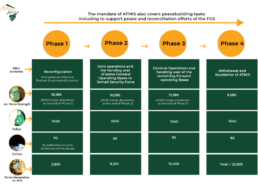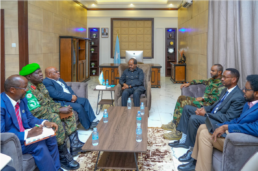Update on the situation in Somalia and activities of ATMIS
Date | 13 September 2023
Tomorrow (14 September) the African Union (AU) Peace and Security Council (PSC) will receive updates on the situation in Somalia and activities of the African Union Transition Mission in Somalia (ATMIS), at its 1173rd meeting.
The session commences with the opening remark of the Chairperson of the PSC for September, Churchill Ewumbue Monono, Permanent Representative of Cameroon to the AU, followed by a statement from Bankole Adeoye, Commissioner for Political Affairs, Peace and Security (PAPS). It is expected that the PSC will receive briefing from Souef Mohamed El-Amine, the Special Representative of the Chairperson of the Commission for Somalia and Head of ATMIS. Others that may also deliver statement include the representatives of the United Nations (UN) and the European Union (EU).
Tomorrow’s session will address a number of issues. The first of these relates to the preparations for the drawdown of ATMIS in accordance with the phased timeline set for the transfer of responsibility from ATMIS to Somalia Security Forces (SSF) and eventual withdrawal of ATMIS by December 2024. The second drawdown in accordance with the phased timeline is scheduled to take place by the end of this month. This is expected to involve the withdrawal of 3000 ATMIS troops.

During tomorrow’s session, the PSC is expected to hear from the Special Representative of the Chairperson of the AU Commission and Head of ATMIS about the state of preparedness of ATMIS for the drawdown. On 31 July, the top military commanders of ATMIS held a four-day meeting in Mogadishu both to evaluate the first drawdown and to plan the second drawdown. The meeting thus deliberated on the FOBs that will be handed over to the government of Somalia under Phase two. During the 27 August joint visit to Baidoa in the South West State, ATMIS Deputy Force Commander in Charge of Logistics and Support, Maj. Gen. Muteti, who also leads the ATMIS technical evaluation committee, confirmed that ‘preparations are at an advance stage to drawdown 3000 ATMIS troops’. Earlier this week, El-Amine, the Head of ATMIS, along with the Under-Secretary-General of UN Department of Operational Support undertook a mission to Dhusamareb to review preparations for the second phase of the withdrawal of troops. El-Amine also held a meeting with President Hassan Shiekh Mohamed of Somalia for updating him on the second phase of ATIMS drawdown and the technical assessment of the first drawdown.
The second drawdown is also premised on not only the identification of the 3000 troops to be withdrawn but also the generation of forces by Somalia for taking over security responsibilities from the departing ATMIS troops. It would be of interest to the PSC to be updated on the preparations of SSF for taking over responsibilities. As outlined in the CONOPs, the FGS is expected to generate forces in each phase of the mission along with the phased drawdown of ATMIS. ATMIS drawdown and force generation by the FGS will take place concurrently. Accordingly, the FGS would generate 3,850 security forces at the end of the first phase, whereas 8,525 forces would be generated in the second phase. In other words, while ATMIS withdraws a total of 5,000 troops at the end of phase two, the FGS is envisaged to generate more than 12,000 forces. Yet, taking over security responsibility from ATMIS requires more than generating the requisite number of soldiers. It requires making those soldiers fit for purposes of both fighting Al-Shabaab and significantly holding and stabilizing territories freed from the terrorist group. It is thus imperative that they are equipped with the necessary logistics, technical capacities and financial provisions as well as workable command and control and political and military strategy that has firm support of both the federal government and federal member states.
There seem to be doubts about this given some of the recent setbacks in the offensive operations, which has created concerns about the risk of leaving a security vacuum that could be exploited by Al-Shabaab. The joint assessment report will be critical in understanding these challenges and informing future decisions on the ATMIS drawdown. During the negotiation on resolution 2687, some UN Security Council members were opposed to referencing December 2024 as the timeline for the mission’s final drawdown and exit because of these concerns but other members insisted on the need to state the December 2024 deadline. This is likely to be a controversial issue in the upcoming negotiations on the ATMIS mandate in December with a further drawdown of ATMIS personnel anticipated next year.

The other issue that is expected to feature during tomorrow’s session is the ongoing offensive that the federal government in concert with local militias have initiated. The first phase of Somali-led offensives against al-Shabaab was launched between August of last year and January with Central Somalia (starting in Hirshabelle and then expanding to Galmudug state) as the main theatre of operation. It was hailed as successful, which according to some reports, enabled Somalia to reclaim one-third of its territory formerly lost to the terrorist group. In his briefing to the UN Security Council on 22 June, the Head of ATMIS, Ambassador Souef also reported that the military offensive under the leadership of SSF dislodged Al-Shabaab from over 70 locations across Somalia.
The second phase was announced at the end of March with the aim to expand the military operation toward the southern regions – Southwest and Jubaland states, but it was off to a slow start. Challenges including coordination with local leaders and communities are being encountered, leading to loss of momentum. During the past weeks, Somali security forces reportedly retreated from several areas liberated in recent months as Al-Shabaab launched deadly counter-attacks to retake lost territories. Speaking from Dhusamareb, the capital of Galmudug state, to galvanize support for the ongoing offensive operation, President Hassan Sheikh Mahmoud vowed to continue the fight against Al-Shabaab until a final victory is achieved.
Apart from the offensive launched against Al-Shabaab, Somalia has also sought to bolster its capacity in the face of the drawdown of ATMIS via joint military operation involving the frontline states bordering Somalia. Within this framework, it was preparing to launch an offensive codenamed “Operation Black Lion” and it is banking on the support of frontline states namely Djibouti, Ethiopia, and Kenya who pledged at a regional summit hosted by Mogadishu on 1 February to support the Somali government’s efforts. The PSC may also seek update on whether and how this planned joint operation is progressing. In this respect, one issue that deserves attention is the attacks Al-Shabaab orchestrated targeting the forward operating basis (FOBs) that ATMIS troops handed over to SSF as part of the drawdown, highlighting the need to pay attention to addressing the vulnerability of the forces taking over from ATMIS.
On the issue of Somalia’s campaign for the lifting of the arms embargo, President Mohamud attended a UN Security Council meeting on 22 June to make a strong appeal underscoring the significance of the issue to the fight against Al-Shabaab. The three African members and China supported Somalia’s request, while other Council members stressed the need for the country to strengthen its weapons and ammunition management. Council members expect to receive during September an assessment report from the Secretary-General on progress in Somalia’s weapons and ammunition management ahead of their negotiations on the extension of the 751 Al-Shabaab sanctions regime in November.
Another important issue that deserves the attention of PSC members at tomorrow’s meeting is the security situation in Las Anod, a disputed area between Puntland and Somaliland. The region saw rising tensions since February because of fighting between Somaliland and Khatumo forces who want to be governed from Mogadishu rather than from Hargeisa. Somaliland accuses Puntland of supporting and abetting the Khatumo forces. Several days ago, renewed fighting commenced, resulting in significant casualties among Somaliland forces. Somaliland’s President Musa Bihi is now vowing to retaliate and there seems to be a major mobilization in this regard. ATMIS, IGAD, the UN, and other bilateral and international partners issued a joint statement on 27 August strongly condemning the escalating violence in Las Anod and urged all sides to agree to an immediate and unconditional ceasefire. They also called for an end to the mobilization of fighters and to the provision of supplies and armaments, underscoring the need to resolve all grievances and tensions peacefully and through dialogue.
The expected outcome of the session is a communiqué. The PSC is expected to commend the Government of Somalia for the ongoing operation against Al-Shabaab and for the support from ATMIS. The PSC may encourage Somalia to continue enhancing the effectiveness of its troops and the strategy for holding territories reclaimed from Al-Shabaab. The PSC may also welcome the preparations undertaken by ATMIS and Somalia for the second phase of the drawdown and may call on them to ensure that the lessons learned from the first drawdown are adequately applied in order to avoid some of the gaps observed, including in relation to the transfer of FOBs from ATMIS troops to SSF. In the light of the capacity to orchestrate attacks that Al-Shabaab continues to display and the need for averting the emergence of security vacuum, the PSC may request that the drawdown is undertaken with due regard to the need for sustaining momentum and avoiding security relapse. PSC may reiterate its support for the lifting of the arms embargo on Somalia and the need for the provision of support for expanding Somalia’s capacity in ammunition stockpile control and management. With respect to the fighting in Las Anod, the PSC may welcome the 27 August joint statement and echo the call on all parties to agree to an immediate and unconditional ceasefire and seek to resolve their disputes through negotiation.